9 May 2010
what are we in for?
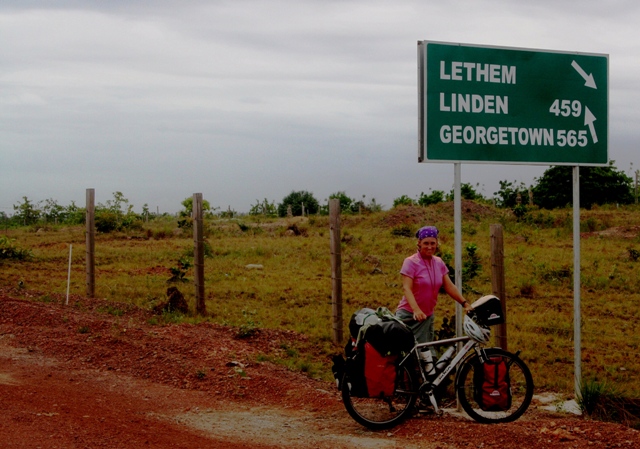 I
sat in perfect contentment and watched the steady fall of the rain.
No immediate worries plagued us. We had found
shelter at the Pirara Ranch. Once one of the largest cattle operations
in South America, it was now just a cluster of decaying buildings some 35 kilometers from the Brazil border.
I
sat in perfect contentment and watched the steady fall of the rain.
No immediate worries plagued us. We had found
shelter at the Pirara Ranch. Once one of the largest cattle operations
in South America, it was now just a cluster of decaying buildings some 35 kilometers from the Brazil border.
All morning we'd been slogging away on 'the trail.' That's how locals refer to the 460 kilometer dirt track connecting the border outpost of Lethem with Guyana´s capital, Georgetown.
bad timing
We'd picked a bad time to attempt The Trail. After a near drought, the rainy season had arrived with a vengeance. Riding The Trail in the rainy season meant contending not only with the usual man-sized pot-holes, bone-jarring corrugations and sand traps, but also with mud and muck. The exasperatingly sticky kind prone to clogging bike chains, making it impossible to pedal.Gazing out at the beating drops battering the soft red earth, I wondered how long it would be until the swollen river beyond burst its banks.. Between our haven at Pirara Ranch and the paved road leading to Georgetown, lay the empty Rupunini Savannah, which was flooding fast, and beyond, a riot of thick jungle and rushing rivers. How would we make it to Georgetown?
The last couple who'd passed this way on bikes had opted to hop on a bus. And that had been in the dry season. More than a year had passed since we'd tackled any really rough terrain. Taking on southern Ethiopia's mangled roads seemed like an eternity ago. We'd gone soft, gotten used to smooth tarmac and well-stocked supermarkets.
* * *
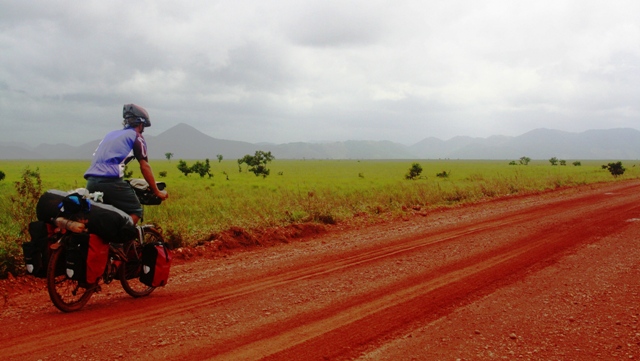 We
weren't the only ones
seeking shelter at the ranch. Two guys stampeding cattle to some
remote Amer-indian village had hung their hammocks on the veranda.
I'd spotted them on the road prodding the stubborn beasts.
At first I'd taken them for cattle rustlers. They turned out to be
honest, hardworking ranch hands on a two-week cattle drive. All
on foot, burdened by heavy packs and un-cooperative
cattle. The territory was too rough to go on horseback, they explained.
Biking The Trail, I decided, didn't amount to much of an adventure in comparison.
We
weren't the only ones
seeking shelter at the ranch. Two guys stampeding cattle to some
remote Amer-indian village had hung their hammocks on the veranda.
I'd spotted them on the road prodding the stubborn beasts.
At first I'd taken them for cattle rustlers. They turned out to be
honest, hardworking ranch hands on a two-week cattle drive. All
on foot, burdened by heavy packs and un-cooperative
cattle. The territory was too rough to go on horseback, they explained.
Biking The Trail, I decided, didn't amount to much of an adventure in comparison.mud, muck and stocking up
Six days seemed sufficient to make it to Georgetown. Knowing we'd be passing through some remote territory, we'd stocked up on provisions. A large canister of powdered milk, two packs of quick-cooking oats, 5 cans of tuna, a kilo of pasta, 500 grams of rice, 3 tins of tomato sauce, a giant jar of guava jam, ramen noodles, a loaf of whole-wheat bread, some hard cheese, a jar of mayo, a jar of locally-produced Tandy's peanut butter, soya chunks, instant soup, a couple of cans of lentils and some hard-boiled eggs. Plus some cookies--but those didn't last long. Our panniers were bulging.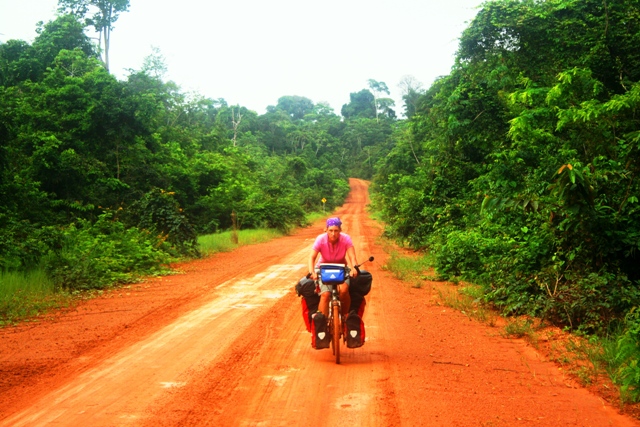 Day
two was more of the same mud and muck. We were fast becoming
experts at the chain de-clogging process. Find a nice sturdy
stick, wedge it between the tire and mud guard and scrape out all the
gooey gunk. Eventually I renounced the stick and attacked the mud with
my bare hands. It was far more efficient.
Day
two was more of the same mud and muck. We were fast becoming
experts at the chain de-clogging process. Find a nice sturdy
stick, wedge it between the tire and mud guard and scrape out all the
gooey gunk. Eventually I renounced the stick and attacked the mud with
my bare hands. It was far more efficient. On Day Three wide open savannah abruptly gave way to thick tropical forest . We'd passed the occasional cluster of thatched huts that make up traditional Amer-indian villages as we rode through the savannah. Now our only company was the howler monkeys darting between the trees and the brightly colored birds soaring and screeching high up in the canopy. For almost 100 kilometers at a stretch, absolutely no signs of human habitation blemished the pristine jungle.
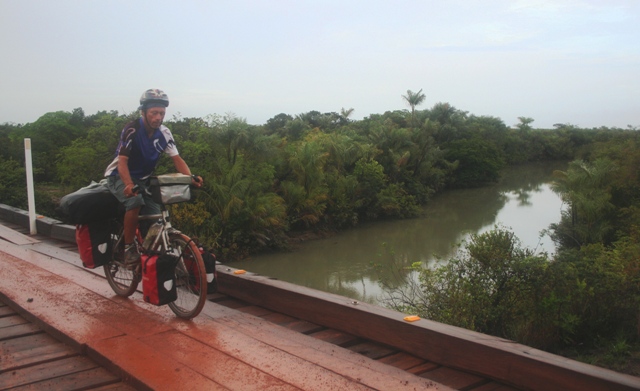 The
road cutting through the jungle was narrow and lonely with little
traffic. Despite being just 5 degrees north of the equator, the thick
foliage and overcast sky kept the forest refreshingly cool. At
times the jungle opened up, but this terrain was invariably flooded and
unsuitable for camping. Foolishly, we had forgotten to pack a
machete. With a machete we might have hacked through
the foliage to clear a camping spot. A hammock might have been useful,
but a tent is impractical gear for the jungle.
The
road cutting through the jungle was narrow and lonely with little
traffic. Despite being just 5 degrees north of the equator, the thick
foliage and overcast sky kept the forest refreshingly cool. At
times the jungle opened up, but this terrain was invariably flooded and
unsuitable for camping. Foolishly, we had forgotten to pack a
machete. With a machete we might have hacked through
the foliage to clear a camping spot. A hammock might have been useful,
but a tent is impractical gear for the jungle.Reaching civilization on the far banks of the Esequibo River by day's end seemed a must. There we were assured a place to spend the night. Road conditions had improved, the rains had let up and we were bumping along at a reasonable speed. Still, cranking away 100 kilometers before nightfall meant bringing it up a notch.
A bridge across the muddy waters of the Esequibo is apparently in the works, but for now a pontoon transports vehicles across the river. On the far banks a few enterprising locals have set up rest stops for travelers who miss the last ferry. It was either forge on to the rest stop or spend a soggy night in the jungle.
In the end, we hopped on the last ferry of the day and pedaled into the rest stop just before sunset. Filthy, feeble and famished, but thankful for a nice dry spot to pitch the tent. In the morning the generous proprietors, a kind couple of Indian descent, sent us away with provisions of piping hot fry bread to sustain us until the next settlement--again some 100 kilometers away.
nearing civilization
Day Four passed in a blur of rough roads, hilly terrain and torrential rains. We reached our first substantial settlement since leaving Lethem, a place called Mabura Hill. It was a dreary company town, existing for the sole purpose of supplying labor to the adjoining Chinese owned sawmill. We set up camp at the Border Line restaurant, pushing a few tables out of the way to make room for the tent. Throughout the night, rain pounded the metal roof overhead. I listened to the steady thump of the tropical deluge and counted my blessings.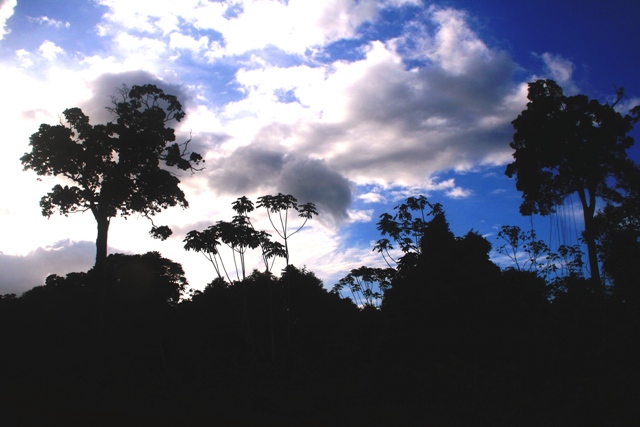 A
gaggle of roadside restaurants known as Mile 58 was our first (and as
it turns out only) stop on Day Five. For some reason, we'd
imagined Mile 58 marked the beginnings of civilization and an end to
the hills. The road widened up, but still there was another
empty stretch of almost 100 kilometers to reach Linden, Guyana's second
city. Under a steady late afternoon rain, we concurred that it
would be impossible to reach Linden before nightfall. The road was in
horrific condition, covered by a thick, glue-like mud that made
pedaling a near impossibility on many stretches. The land
adjoining the road side was nearly all flooded and I couldn't
imagine pitching the tent in a swamp.
A
gaggle of roadside restaurants known as Mile 58 was our first (and as
it turns out only) stop on Day Five. For some reason, we'd
imagined Mile 58 marked the beginnings of civilization and an end to
the hills. The road widened up, but still there was another
empty stretch of almost 100 kilometers to reach Linden, Guyana's second
city. Under a steady late afternoon rain, we concurred that it
would be impossible to reach Linden before nightfall. The road was in
horrific condition, covered by a thick, glue-like mud that made
pedaling a near impossibility on many stretches. The land
adjoining the road side was nearly all flooded and I couldn't
imagine pitching the tent in a swamp.a short-lived reprieve
We waved madly at the next vehicle that appeared and a huge flatbed truck came to a sliding halt . Tough conditions on The Trail meant drivers had developed a strong sense of solidarity. Without even exchanging words, two muscle-bound young men hopped down and heaved the bikes onto the truck. We climbed aboard and within moments the truck was flying down the road. We bounced along at breakneck speed. Eric and I holding on for dear life, the bikes taking a serious bashing, the driver and other passengers seemingly oblivious to the dangers and discomforts of speeding along a rough, rutted and muddy track."Let us down," I shrieked. Over the roar of the engine, no one heard. I began to stamp my feet and beat on the high metal side board of the truck. "Stop, Stop, we want off."
One of our fellow passengers took notice. A young rasta guy, who'd so expertly loaded on the bikes. "No problem, man. He best driver."
"Off," I implored, "We want off." He nodded, made his way to the cab, crawled on top, and lowered himself down through a hole in the roof and shouted something at the driver.
We screeched to a sudden halt, the men lowered down the bikes, and the truck was off, spraying us with thick, red mud as the driver peeled away.
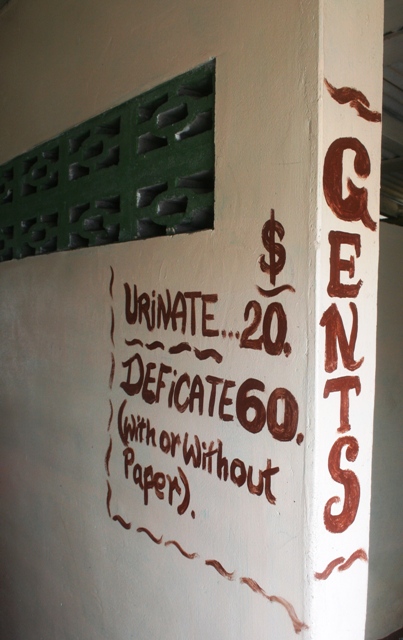 It
was a short-lived reprieve from pedaling. The ride had cut off
around 20 kilometers, we reckoned. With a bit of luck we just
might make Linden before sunset. We plodded on, pedaling and pushing
and praying.
It
was a short-lived reprieve from pedaling. The ride had cut off
around 20 kilometers, we reckoned. With a bit of luck we just
might make Linden before sunset. We plodded on, pedaling and pushing
and praying.The light began to fade and I flagged down a car headed in the opposite direction. "How far to Linden?" "You are near, very near, maybe an hour away by bicycle." came the answer. "Why don't you catch a ride on the back of a truck?"
I rolled my eyes and slogged on.
Another hour passed and still no sign of civilization. It was pitch black now, heavy clouds blocking out the star light. Eric got a puncture, but there was no place to possibly repair it. Through the deep, wet sand, it was nearly impossible to ride anyway so we pushed on together in silence.
Nearly two hours after sunset, the first lights of Linden appeared in the distance.
We pulled off onto the first side road and wandered into a roadside shop. "You look like you come from The Trail." I sighed and mustered a smile for the enormous lady with a gentle face. "Yes, we've been riding from Linden. Five days now. We're hungry and tired. You know any place we might pitch our tent? Some place safe where nobody will knife us in the night."
It was a stupid thing to say, but the lady laughed and then spoke to her husband, "Whadda ya think, John?"
"Come on," and he motioned for us to follow him.
It was a musty garage, full of empty jerry cans reeking of gasoline, old bottles and broken appliances. Not some place I'd usually consider pleasant for camping. But we were content just to find a dry place to rest our exhausted bodies.
We had reached the end of The Trail, the tarmac had begun. It felt as if we had been on the road for weeks. I lay down to rest and reflect on all we'd been through. The Trail had been an adventure, and not one I'm sure I'd readily re-live--at least not in the rainy season.
If you enjoyed this post, you might like these posts, too:
Cycling around the World Video
Biking Guyana Video
Tour Update
Cycling
Around the World: Biking Venezuela
Touring Talk Video
Interview with world traveler and cyclist Bob Sara
If you enjoyed this post, please share it with others via Twitter.
How do you discover places off the beaten path? Any body keen to join us and take on those climbs?
Please share in the comments section below.

| Get World Biking Newsletter |
| Email: |
| |
check out more photos from our trip
contact us at: worldbiking@gmail.com



